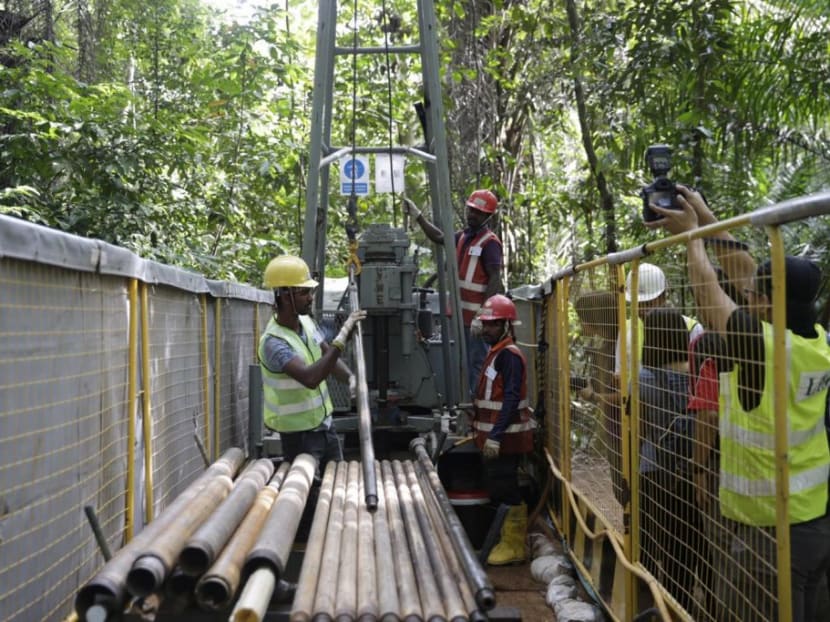Express train service on Cross Island Line off the table: Khaw Boon Wan
SINGAPORE — An express MRT train service that would get commuters more quickly from one end of the future Cross Island Line (CRL) to the other will not materialise after all. This is after the authorities projected that just less than 5 per cent of the rail line's users would see time savings of at least 15 minutes.

Site investigation works for the future Cross Island Line being carried out at the Central Catchment Nature Reserve.
SINGAPORE — An express MRT train service that would get commuters more quickly from one end of the future Cross Island Line (CRL) to the other will not materialise after all.
This is after the authorities projected that just less than 5 per cent of the rail line's users would see time savings of at least 15 minutes.
In a written reply to a parliamentary question by Mr Ong Teng Koon, Member of Parliament for Marsiling-Yew Tee Group Representation Constituency, Transport Minister Khaw Boon Wan also said on Monday (Nov 19) that the benefits of significant time savings do not outweigh the cost.
Based on the CRL’s daily ridership estimate of 600,000 commuters, fewer than 30,000 people would benefit from this service.
“Viewed against the much higher cost and land take needed to build two additional tunnels for the express service, we did not pursue the option,” he added.
Mr Khaw explained that while express services can reduce travel time, they require a separate set of tracks and additional signalling systems.
“This will mean greater land take, pose operational complexities, and cost taxpayers and commuters significantly more,” he said.
An express service on the CRL was first mooted in 2014, when the Land Transport Authority (LTA) called for an engineering feasibility study for running both regular and express trains on the new line, which will be ready in 2030.
The 50km MRT line will start from Changi in the eastern part of Singapore, and end at Jurong in the west, passing through Loyang, Pasir Ris, Hougang, Ang Mo Kio, Bukit Timah, Clementi and West Coast.
Transport analysts told TODAY that they were not surprised by the Government’s decision.
Transport economist Walter Theseira from Singapore University of Social Sciences (SUSS) pointed out that express train services usually need twice the amount of trackage.
While it is possible to intermix the tracks for the express and regular train service, it is “more dangerous”, and may slow down both services as one train will have to stop to let the other pass, he said. Mr Khaw also pointed this out in his written reply, stating that this will have a “significant adverse impact” for commuters on the regular train services, as they would have to be held back at certain stations for the express trains to pass.
Dr Theseira added that there must be a pattern demand to justify the huge expense of running an express service — such as having many commuters getting on and off at both ends of the services, or only alighting at major interchanges located in the Central Business District.
SUSS' urban transport expert Park Byung-Joon said that building an extra line for an express service would “cost a lot of money”.
While he could not give an estimate of the total cost of running such an express service on the CRL, Dr Park said that 1km of track would typically cost more than S$1 million, with expenditure going up in Singapore because the tracks would be underground.
While South Korea and Japan’s transport systems have express services, he said that the costs to build those tracks are “a lot cheaper” because they are situated at ground level.
Dr Park added: “It’s really a cost-benefit analysis — how much money to put in extra to have time savings. If the time savings is an extra 15 minutes, it’s not a wise way of spending money.”
There was talk previously that an express service on the CRL would entice residents in southern Malaysia to fly out of Singapore instead of Malaysia's capital Kuala Lumpur, as the CRL would be linked to the Kuala Lumpur-Singapore High-Speed Rail (HSR) at the Jurong terminus. In September, the multi-billion-dollar HSR project was formally postponed by almost two years.
The Singapore Government is now deciding between two alignment options for the CRL — one that runs directly beneath the Central Catchment Nature Reserve, and another slightly longer route which skirts around the nature reserve that would cost S$2 billion and increase travel time by four minutes.
The first option had drawn opposition from environmentalists and conservationists, who said that such a move would seriously damage the reserve and its ecosystem. The authorities have assured the public that a decision would not be made without a full range of studies, which include a “robust” two-phase environmental impact assessment.
Site investigations, which took place from May 2016 to September last year, were conducted after the first phase of the environmental study.








